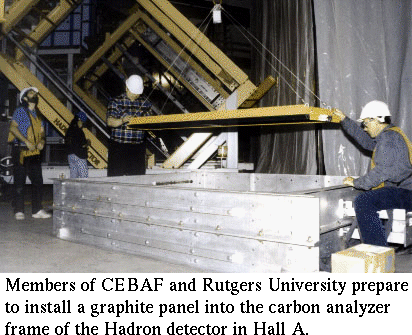Heavy Hall B carriages mobilized by simple technology
Equity through Compensation
Don and Estelle Seeley Share a Combined 36 Years at CEBAF Site
Information Superhighway Leads to CEBAF
Lab Participates in Internet Fair II
Partners Collaberate To Bring Facility To Fruition
CEBAF Partner Wins R&D 100 Award
All Aboard
Fall Captain's Choice Golf Tourney Results
Bowling League Set For January
Computer Network Provides Valuable Communication Links
Riding On Air
Heavy Hall B Carriages Mobilized By Simple Technology
The strength of one person and seven inflated inner tubes is about all that's required to move the Forward Carriage-a mere 225 tons-in Hall B. An extraordinary feat no doubt, but how about the fact that once inflated, the tubes and the attached three-story structure all actually float.
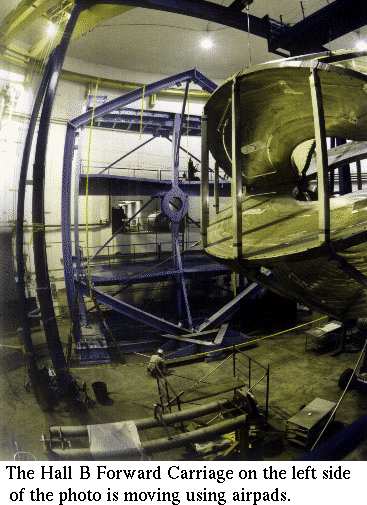 There's no magic involved. Just Newton's laws of motion and seven airpads, which resemble tire inner tubes. Once inflated, and the air pressure inside the tube and the ring become approximately 50 pounds per square inch, air escapes beneath the tube creating a cushion of air. As a result, the structure floats. A winch is then attached so that someone can guide the structure to its final destination.
There's no magic involved. Just Newton's laws of motion and seven airpads, which resemble tire inner tubes. Once inflated, and the air pressure inside the tube and the ring become approximately 50 pounds per square inch, air escapes beneath the tube creating a cushion of air. As a result, the structure floats. A winch is then attached so that someone can guide the structure to its final destination.
"The secret is to have a well sealed floor," says John Robb, Hall B Installation Coordinator, referring to the shiny epoxy coating covering one-fourth of the experimental hall floor.
Situated under an orange platform, the airpads slide into place-three in the front, four in the back-like a drawer. Wheels and tracks, the method used for moving the detectors in Halls A and C, would have seemed to be a more natural choice. But designers of the project thought differently. "Using airpads keeps the floor clear," says Addison Lake, a mechanical engineer for Hall B and lead designer on the carriage. He explains that rails would have to be bolted to the floor making it difficult for workers and vehicles to maneuver. Robb adds, that the airpads are also the least expensive method and they aren't limited in the direction they can move.
The technology isn't new, however. In fact, it's the same used to move heavy airplanes under construction or undergoing maintenance. Some high-energy nuclear physics laboratories use airpads to move massive equipment, as well.
The stately hexagon-shaped Forward Carriage, constructed by Monde Construction in Newport News, hosts a variety of detectors constructed to track particles during experiments. The detector package includes: six triangular electromagnetic calorimeters, which tell how much energy a particle will deposit once completely stopped; six Cerenkov Counters, which separate electrons from heavier particles; and 132 time-of-flight scintillation detectors, which measure the velocity of slow particles and help identify the particle species. All are a part of the CEBAF Large Acceptance Spectrometer, or CLAS-recognized as one of the biggest, most complicated detectors in the world.
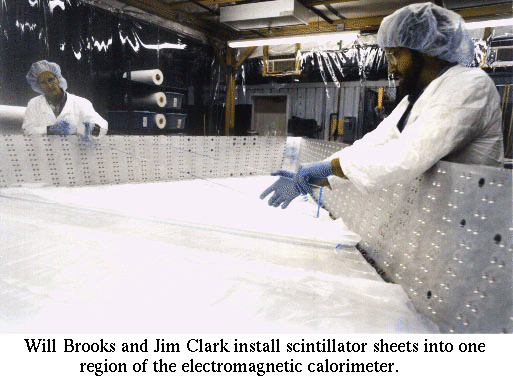
Once all of the detectors are fully installed, the Forward Carriage, now resting near the back wall of Hall B, will be nudged toward the suspended toroidal magnet. Though close, the two structures will never touch. "The Forward Carriage will look almost like a shield," says Robb demonstrating by balling up one hand into a fist and the other looming open beside it. Everything will be located precisely, "within a few millimeters," he adds.
Each level of the carriage also serves a function. The first level will be used to store all of the delay line cables necessary to make all signals arrive at the electronics at the proper time; the second and third will contain electronics racks; and the fourth contains the transformers which will supply the power.
Adding to the weight of the carriage is 25,000 pounds of lead buried inside of it to act as a counterweight since the carriage is tall and the center of gravity will be far forward once the detectors are installed. The calorimeters and time-of-flight scintillation detectors will be installed first, starting in December.
The Forward Carriage isn't the only structure in Hall B being maneuvered by airpads. They will also be used to mobilize two carriages on the sides of the toroidal magnet called Sideward Carriages or "clam shells." These two carriages, containing more calorimeters and time-of-flight scintillation detectors, will close around the toroidal magnet like two cupped hands, says John O'Meara, Chief Engineer for Hall B.
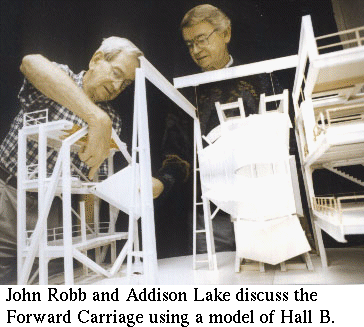 These two additional carriages, currently under design, will have to be fabricated in the hall, and maneuvered to their positions in an environment that is already crowded.
These two additional carriages, currently under design, will have to be fabricated in the hall, and maneuvered to their positions in an environment that is already crowded.
"Hall B is looking smaller and smaller to us each day," O'Meara admits. "But everything will fit."
Testing the effectiveness of the airpads was left up to Hall B lead mechanic, Doug Tilles, and his crew. Once the airpads were inflated by a rented 900-cubic foot per minute air compressor, the empty Forward Carriage-weighing 160,000 pounds-moved with ease.
O'Meara is optimistic about the effectiveness of the airpads after all of the detectors are installed. He also notes that once filled, all three carriages will only be moved a few times a year for maintenance.
Now that the obstacles of moving these structures seem to have been overcome, the challenges still aren't over for the team. Now they must figure out how to actually get the calorimeters into the cavernous experimental hall. After each is wheeled down the 320 foot long access ramp, the triangular detectors will have to fit through a square door. "It's going to be tight ... very tight," says Robb. "The calorimeters will have to be tipped up at a 50 degree angle. They will just clear the door."
"We're all convinced that everything will work. It all has to be just right," says Robb.
-Deborah Hyman
Diane Anderson
Equity through Compensation
Diane Anderson's work touches every employee at CEBAF, and most are not even aware of it. Working behind the scenes of Human Resources, Anderson makes the evaluations that impact employee compensation and benefits.
CEBAF's new Compensation and Benefits Manager advises supervisors and Associate Directors about the compensation packages offered to transferring and new employees.
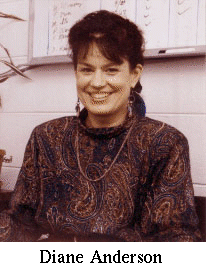 Working with people is nothing new for Anderson. After graduating from Mary Washington College in Fredericksburg, Virginia, she worked in a legal-aid office.
Working with people is nothing new for Anderson. After graduating from Mary Washington College in Fredericksburg, Virginia, she worked in a legal-aid office.
"I felt like I was making a difference in people's lives by helping them navigate bureaucratic mazes. Much of what we did was band-aid work, but every once in a while you experienced a breakthrough and succeeded in getting someone back on their feet. I continue to use the listening skills learned through the experience in my work in Human Resources," says Anderson.
After 3 years in legal aid, Anderson advanced to accumulate 16 years in the Human Resources Field. She most recently worked for the Virginia State Department of Mental Health, Mental Retardation and Substance Abuse Services for three and one-half years. Commuting round-trip from her home in Midlothian, VA to CEBAF, Anderson has committed herself to designing systems which ensure the equitable and efficient delivery of Human Resource services.
Her principal responsibility is interpreting and conducting marketplace evaluations to ascertain the levels and types of compensation organizations are offering in the marketplace.
"The objective is attaining internal parity of compensation between similar positions, and continuing to attract the best and brightest from the marketplace to CEBAF," says Anderson.
Anderson's ongoing focus is developing a comprehensive infrastructure of job descriptions for each position at CEBAF. Such a system has not been completed due to CEBAF's relatively brief time in operation. "I like the challenge of designing new systems that fully consider the culture, mission, and work force of an organization," says Anderson. According to Anderson, future demands on resources may necessitate a shift in compensation strategies and delivery. She is exploring benefit options that provide additional benefits to employees without representing added costs for the organization.
An examination of the compensation programs of other organizations illustrates that CEBAF is competitive in the local marketplace. "SURA provides its employees with an appropriate compensation package," says Anderson.
- Will Conners, Director's Office Intern
Dedication Exemplified
Don and Estelle Seeley Share a Combined 36 Years at CEBAF Site
CEBAF has come a long way in its short 11 year history. Very few staff members can say that they were here when the facility consisted of a couple of buildings on a large plot of land. Don and Estelle Seeley are members of this special group who have been here from the beginning.
On November 1st, CEBAF celebrated the service of employees like the Seeleys who have achieved 10 years of service in a ceremony honoring their accomplishments. Nine people have attained 10 years as of 1994, while 22 have reached that mark in the current year. The facility also honored the 89 staffers who have completed five years of service.
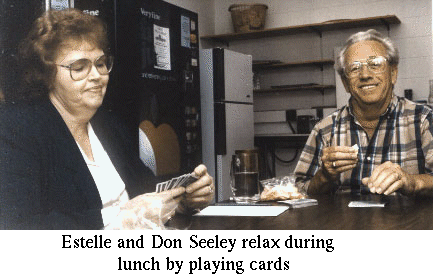
Don began working as a state employee in 1974. He was assigned as a maintenance supervisor to the Virginia Associated Research Campus of the College of William and Mary, which is the namesake for the VARC building. In those days, VARC was used as a cancer research laboratory as well as classroom space for William and Mary night classes. "Back then half of the offices that are currently in VARC were open bays populated by mice and rats that were used in experiments," Don says.
Don is currently responsible for completing work orders, which can be as simple as hanging pictures in CEBAF Center, to overseeing the quality of work of contractors. He has seen those responsibilities expand from maintaining one building to over a hundred buildings and structures that now cover the site.
Along the way, Don managed to meet his wife, Estelle. She began at VARC in 1980 working for Don as a custodial worker. She has since worked her way up through shipping and receiving to her current position in the Procurement Department. As a buyer, Estelle is responsible for placing supply orders totaling $25,000 or less and making sure the order is filled in a timely manner.
Estelle credits the many opportunities present at CEBAF with aiding her in achieving her level of success. "CEBAF has opened doors which might have been closed to me in other companies. I have worked for some great supervisors who recognized my potential," she says.
The Seeleys believe in putting their private lives behind them while on the job. They do, however, have a standing date for lunch everyday, where they usually play a game of cards with a few of their co-workers.
The ethic of teamwork that prevails throughout the laboratory is what Don enjoys most of all about CEBAF. "From the very beginning, I told Hermann (Grunder,CEBAF Director) that CEBAF would make it, because everyone was willing to work together. There were times when Hermann would come out and help shovel snow off of the walkways," says Don. He also remembers one instance in which Jim Coleman, Associate Director of Administration, came in on a Saturday to help bail water out of VARC after a water pipe had burst. "Things like that showed everyone that the big guys truly cared about getting CEBAF off of the ground," says Don.
Estelle shares her husband's enthusiasm for the facility's staff. "It's been exciting to witness CEBAF become what it has and to work with the people that have contributed to its success," she says. "Don and I believe in always putting our best foot forward in order to keep the spirit of teamwork alive."
Although Don and Estelle enjoy working at CEBAF, they both look forward to the day when they can retire. Don has grand plans of going out fishing everyday in his boat. Estelle, on the other hand, says she does not have any definite plans for her retirement, but is assured that she will be able to find plenty to do. Don says if he has his way, Estelle might end up cleaning the day's catch.
- David Ellis, Director's Office Intern
Information Superway Leads To CEBAF
Lab Participates in Internet Fair II
There are many roads that lead to CEBAF-down interstate 64, Oyster Point Road, Victory Boulevard, or just straight down Jefferson Avenue. However, the newest way to get to the laboratory is the Information Superhighway.
CEBAF, like thousands of other government agencies, businesses, information organizations, and private citizens, has posted a site on the World Wide Web. The site, or "homepage," can be found at (http://www.jlab.org) and provides information pertaining to CEBAF.
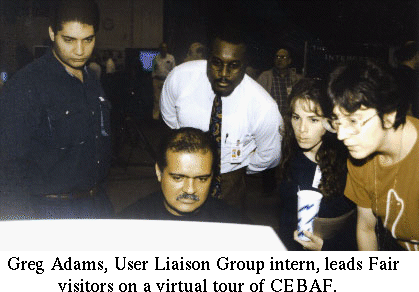
CEBAF was recently invited by NASA to participate in Internet Fair II. Just under 2,000 people attended the fair, which was held October 23 and 24 at NASA/Langley's Reid Conference Center. Internet Fair II, which can be found on the Internet at (http://www.larc.nasa.gov/if2/), provided a forum for NASA to exchange information technology with over 30 other Hampton Roads businesses and organizations.
CEBAF's theme for its booth was "Science, Technology, and You-The Making of the Universal Citizen." The theme focused on bringing the government laboratory to the citizen by redefining the role of technology development in a community setting through the use of active archives.
"The Fair let us advertise our web site which allows the users, employees, and the general public easy access to topics of information such as CEBAF's mission, the accelerator schedule, news and events, the experimental program, or user Environmental Health and Safety (EH&S) training," says Karen Hokansson, User Liaison Group Administrator. "The web site is a very effective means of posting a vast amount of information to people worldwide without the cost and time spent sending out thousands of mailings," she adds.
Other Fair participants included organizations in the fields of entertainment, education, special interest groups, and transportation. WVEC-13, a local television station, demonstrated its use of the Internet as a tool to supplement its programming. The Satellite Committee for People with Disabilities displayed how information technologies are instrumental in providing a limitation-free work environment.
"The Fair provided CEBAF the opportunity to compare and share ideas about using the available information technology with other organizations in an atmosphere free from competition. No one company tried to outdo another. Everyone was just there to help each other out," says Hokansson.
- David Ellis, Director's Office Intern
Applied Research Center
CEBAF Partners Collaborate to Bring Facility to Fruition
Like many CEBAF projects, ARC illustrates the power of cooperation. Founded on a partnership between industry, government and universities; the Applied Research Center will be the newest addition to CEBAF's site.
The future 120,000 square foot facility will be constructed adjacent to the VARC Building at the corner of Lawrence and S.C.O.T. Boulevards. The Center will relieve CEBAF's shortage of office space, and provide a facility where laboratory partners can collaborate on a range of research efforts.
Initial development of the Center was the product of talks held between city leaders and CEBAF. Newport News Mayor Barry DuVal says that he and other council members were investigating ways that the city could facilitate private and public sector investment in CEBAF.
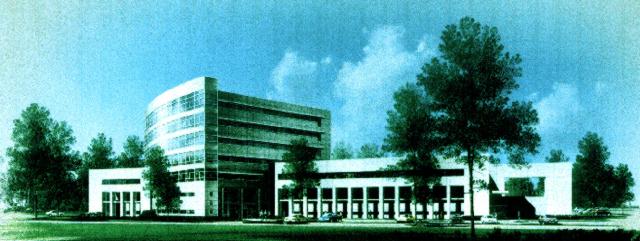
As a result of the explorative talks, a proposal for ARC was developed and architectural plans designed by the firm of Rancorn, Wildman, Krause, and Brezinski. The universities of Christopher Newport University, Old Dominion University, and William and Mary College formed a partnership agreement committed to leasing 30,000 square feet for cooperative research, development activities, and graduate training. Commitments for 35,000 square feet of the space have been made by CEBAF, and the Newport News Industrial Development Authority which will reserve remaining space for industry partners and future expansion.
With lease commitments in hand, the Newport News City Council approved a $14 million dollar expenditure to plan and construct the facility. The city's investment will be recouped through lease revenue. City officials plan to use ARC as an anchor for a city-planned Research and Development Park adjacent to CEBAF. "The development and expansion of CEBAF places Newport News on the vanguard of communities considered as possible sites for leading edge industrial development," says Mayor DuVal.
ARC's partnering universities have been working on established research efforts during the conception and planning of the project. ODU and W&M are cooperating on a number of efforts including the fabrication, testing, and analysis of thin diamond films. The artificial diamond films have the potential for industrial application in tooling and electronics. ODU and W&M are also investigating flat panel computer displays as well as developing new ultraviolet light sources in collaboration with Xerox and DuPont. The light sources have numerous applications identified by industry members of CEBAF's Laser Processing Consortium.
CNU's Laser and Photonics Laboratory is collaborating with CEBAF to prepare precision control equipment for the operation of the Free Electron Laser. The University is also cooperating with CEBAF and NASA to develop a computer chip for specific physics-based applications. The chip will be used in Hall B to sort through massive quantities of data.
Fred Dylla, who serves as CEBAF's representative on the ARC Planning Committee, says that in the spirit of cooperation, area universities have been collecting valuable scientific equipment for consolidation and pooling in ARC. The effort should avoid duplicating costly resources. Dylla adds that ARC will alleviate CEBAF's shortage of office space. "ARC will provide us with space to replace our aging trailer complex," says Dylla.
The architectural package for ARC will be submitted to contractors for bidding in January, and groundbreaking should follow in March. Completion and occupation of the facility is expected in mid-1997.
- Will Conners, Director's Office Intern
BRIEFLY...
CEBAF Partner Wins R&D 100 Award
In conjuction with CEBAF and NASA, Digiray Corporation, of San Ramon, CA, was awarded the R&D 100 Award for work on the reverse geometry x-ray miniprobe (RGM). The transportable system for realtime x-ray imaging is being used to find cracks and corrosion in oil refinery piping. It can locate and measure very small features anywhere on or within the object being examined.
"We are happy to have objective proof to the usefulness of our efforts," says Stan Majewski, staff scientist in charge of the detector group. The group developed the miniprobe through expertise obtained while developing detector technology for the CEBAF experimental program. The miniprobe is composed of a scintillator, light guide and photo detector.
The RGM relies on reverse geometry, which changes the relationship of the x-ray source to the object being x-rayed and eliminates the need for precise alignment. The views delivered are sent directly from detector to computer.
All Aboard
Climb aboard the Spirit of Norfolk for the CEBAF Holiday party from 8:30 p.m. till Midnight, December 2, 1995. There will be a buffet, live music and beautiful view of theParade of Lights on the Elizabeth River. This event promises to be the best party ever!
Cost is $15 per person. This special price is limited to employees, temporary employees, students, Users and contractors. Subcontractors must pay $30 to attend.
Tickets may be purchased at A113 in CEBAF Center. Deadline is November 17, 1995. Don't delay to reserve your place for CEBAF's first party on the harbor. For more information, call the CRC information line at ext. 4002 or Julie Oyer at 7120.
Fall Captain's Choice Golf Tourney Results
Uncertain weather departed and the sun shined, as did the players, in CEBAF's First Fall Captain's Choice Golf Tournament. Forty-four people turned out to enjoy a lovely day in the sun and put on their best performance. It was a close match with the team of Mike O'Sullivan, Mark Cooper, Bob Gravina, and Mark Geeselin taking the match with a 5 under par 65. Second place went to the team of Omar Garza, Harold Davis, Mike Memory, and Eric Woodworth with a 1 under par 69.
Thanks to our prize sponsor, Harold Davis of Phillip Morris USA, many people left with wonderful prizes. Everyone who participated received a sport duffel bag stuffed with lots of goodies. In addition, the company donated several major prizes, including golf bags, travel bags, shirts, putters, umbrellas, and stadium blankets, as well as dozens of golf balls.
Here are some of the winners:
Longest drive on hole 1, Mark Geeselin; Longest drive on hole 17, Eric Woodworth;
Closest to the pin on hole 8, Mark Waite;
Closest to the pin on hole 12, Buddy Carlton;
Closest to the pin on hole 18, Robert Casalino with a tee shot just 2 feet 6 inches from the hole.
Keep your eyes open for the Second Annual Spring Golf Fling already in the planning. Speaking of planning, the CRC would like to thank Julie Oyer, Eric Woodworth, and Mike Zarecky for all their efforts to make this happen.
Bowling League Set For January
CEBAF Bowling League will commence in early January; bowling Monday's at 6:30 p.m. The cost will be determined at the organizational meeting in December (the date will be announced). Watch for fliers and sign up on the CEBAF Recreation Committee's E-mail group for bowlers, rec_bowl.
- Will Conners, Director's Office Intern
ESnet Especially Successful
Computer Network Provides Valuable Communication Links
In today's changing world, team work has increasingly become the key element to the success of any undertaking. For teamwork to be successful, an open line of communication is needed, but the question is how can a team function properly when its members are separated geographically?
For many U.S. Department of Energy funded laboratories, the answer is the Energy Sciences Network. The mission of ESnet is to support open scientific research on multiple programs.
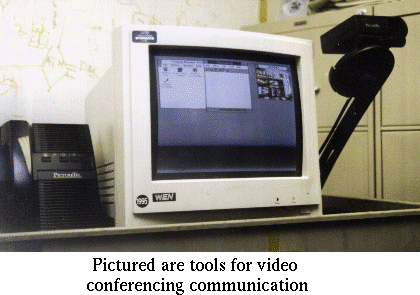 As a "backbone" network, ESnet interconnects Local Area Networks (LANs) of connected laboratories, regional and commercial networks, the global Internet, foreign countries, and other federally funded agencies such as NASA and the Department of Defense (DoD). It allows researchers to collaborate on scientific research via computer by providing widespread access to research facilities, state-of-the-art communications, and on-line information and related services.
As a "backbone" network, ESnet interconnects Local Area Networks (LANs) of connected laboratories, regional and commercial networks, the global Internet, foreign countries, and other federally funded agencies such as NASA and the Department of Defense (DoD). It allows researchers to collaborate on scientific research via computer by providing widespread access to research facilities, state-of-the-art communications, and on-line information and related services.
Since most government agencies are facing budget cuts, ESnet becomes an important cost cutting tool to CEBAF and the other network users. "ESnet allows us to save time and money by providing remote entry into a facility's data base. The network's high-speed access and its quality digital communications, such as video conferencing, makes it possible for off-site researchers to effectively utilize the lab's resources and exchange data without leaving their home base," says Roy Whitney, Head of Computing and Chair of the ESnet Site Coordinating and Distributed Computing Committee.
During the week of September 25 through 29, CEBAF played host to an ESnet conference. At the conference members of the ESnet Site Coordinating Committee (ESCC) and the Distributed Computing Coordinating Committee (DCCC) held joint meetings in which issues concerning the operation of the network were discussed. Some of the topics included the developing of a more secure or private form of e-mail system and improving connectivity to the Internet.
"Another project being coordinated by the DCCC will provide a global file system across all of ESnet and to include universities that are working with connected laboratories," says Whitney.
The network is comprised nationally of over 30 backbone sites and is managed by the National Energy Research Supercomputer Center (NERSC) located at Lawrence Livermore National Laboratory in Livermore, California. However, according to the ESnet Overview booklet, ".the guidance and collaboration that makes the network a success comes from many sources outside of NERSC."
Collaboration, being the keystone of ESnet's success, has proven itself in many research projects. Researchers from Japan, Germany, Italy, and Brazil used the network to work together on the International Thermonuclear Experimental Reactor project.
- David Ellis, Director's Office Intern
On The Move in Hall A
